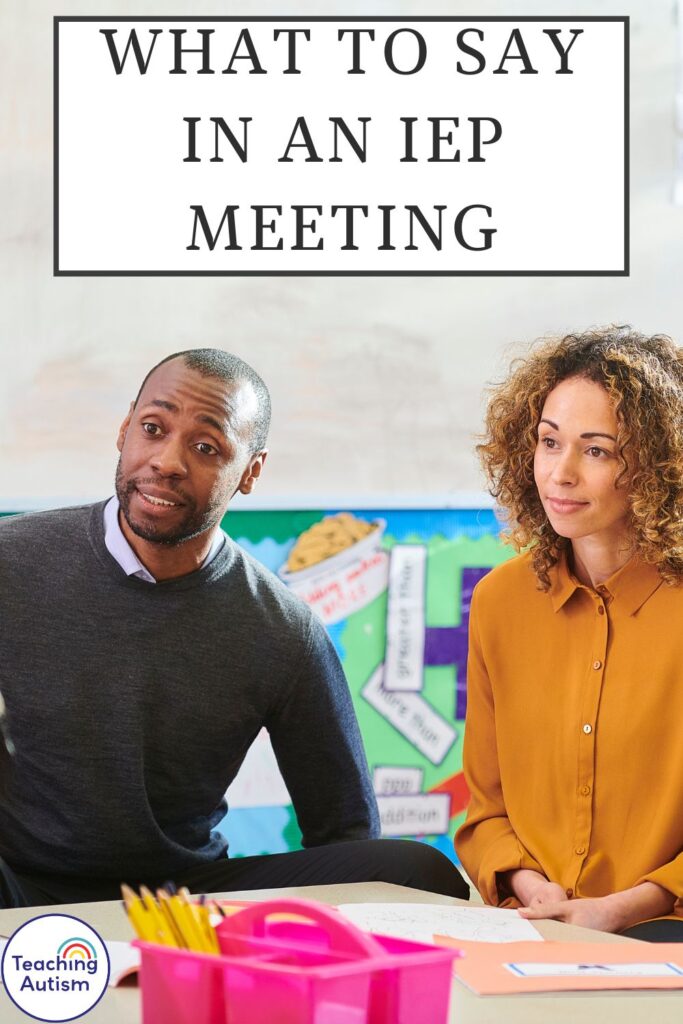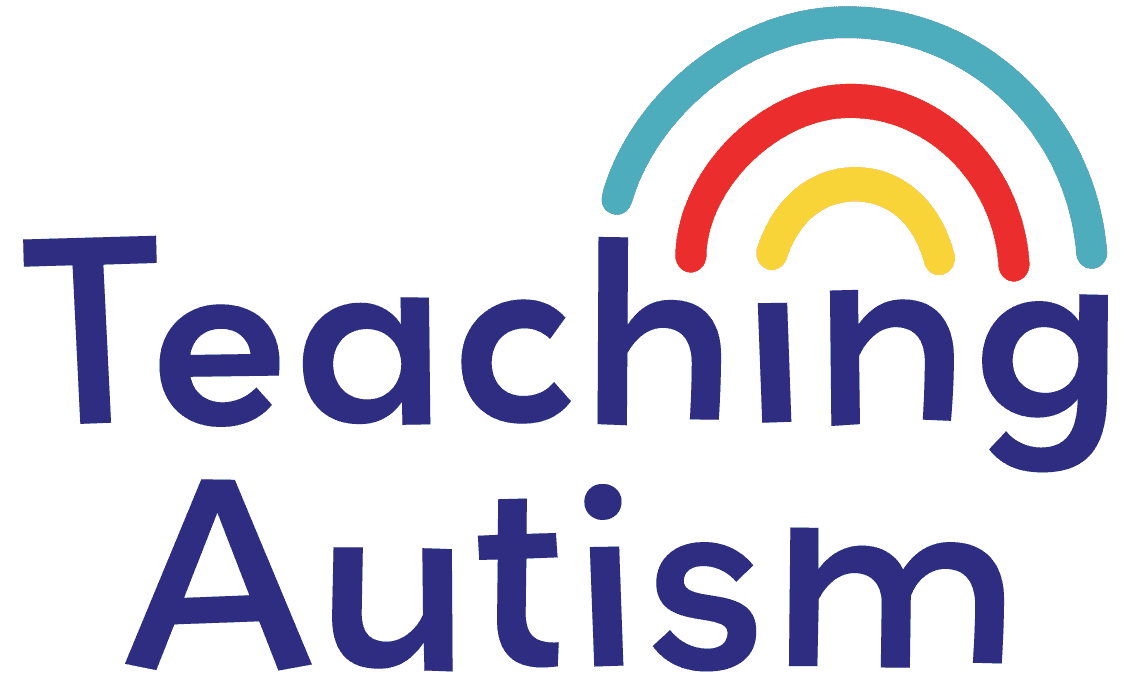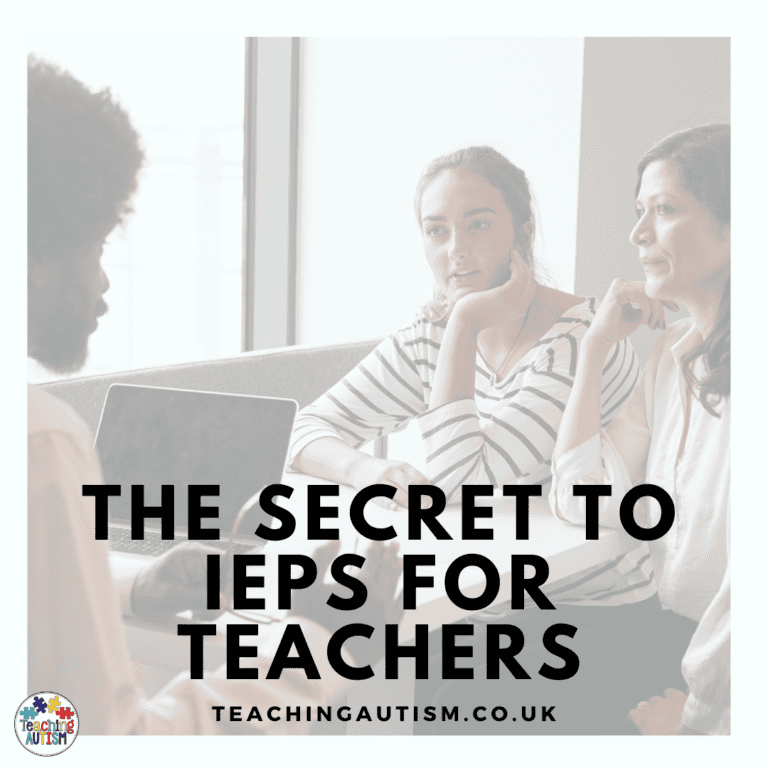What to Say in an IEP Meeting
In this blog post today I’m giving some tips to help you with what to say in an IEP meeting. I’m also giving you some ways to say certain things in a more professional way.. The way that we say things can have a huge impact on what the others in the IEP meeting with respond with. So in this blog post I’m going to to share some more professional ways to say some tricky phrases / sentences / questions.
And if you’re not too sure about what IEPs are, I’d recommend starting here. This is an Instagram visual post I did explaining some facts about what IEPs are.
The aim of this blog post is to discuss what to say and how to say it in an IEP meeting… But before we dive in, just incase this is all completely new to you, I’m going to share some brief information below;
What is an IEP?
An IEP is an Individualized Education Program. It is a document used in the education of students with a disability and it is designed to ensure that students receive an education tailored to their specific needs.
An IEP outlines the unique learning objectives, supports, and accommodations that a student requires to succeed and get all the support that they need in school.
It is developed collaboratively by a team that typically includes educators, school administrators, special education professionals, and the student’s parents or guardians.
What is an IEP Meeting?
An IEP meeting is a involving educators, parents/guardians and sometimes the student to discuss and design the IEP.. Or review it. The goal of the meeting is to ensure that the IEP is meeting the student’s individual needs.
During the meeting, the attendees will look at the student’s current performance, their goals and decide on the services and accommodations that will be provided to help that student strive and to meet their individual needs.
Who is in an IEP Meeting?
Each IEP meeting is different regarding attendees.. This is because it is tailored to meet the students individual needs. Some participants who may attend an IEP meeting are;
- Student; Where appropriate, and especially as a student gets older, they can be involved in their IEP meeting. This gives them the chance to contribute and make decisions about their own learning needs and goals.
- Parents/Guardians.
- Special Education Teacher.
- General Education Teacher.
- School Psychologist or Counselor; This is usually for discussing the student’s emotional and mental health needs.
- School Admin; A principal or director. This is usually for discussing the school’s policies and the resources available.
- Specialists; This can include speech and language therapists, occupational therapists, physical therapists.. All dependent upon the student’s needs.
- Interpreter or Translator; This is common for families and/or students who may require support to communicate and participate in the meeting.
- Advocate / Lawyer.
- Anyone else involved in the child’s education. This can include aides and transportation coordinators.
During IEP meetings, there may be some tricky situations that need to be navigated. And wording things like this can be a little tricky. So I’ve put together a ‘Don’t Say This.. Say That’ section to help you communicate in a professional way that shows your student is who you are focused on and meeting their needs.
I have put together a teacher edition and a parent/guardian edition.
Don’t Say This… Say That (Teacher Edition)
Instead of saying.. “I don’t agree with what you are saying your child needs.”
Try saying.. “I understand that you have noticed some additional areas of support your child needs. Would you mind explaining and share your thoughts surrounding this with me, just so that we can have a clearer picture of why you think they need this and so we put the correct supports in place for XX.”
Instead of saying.. “I think the reason this IEP isn’t working is because XX just doesn’t want to work.”
Try saying.. “I have noticed that XX isn’t feeling motivated with their learning. Obviously we want XX to have an enjoyable and positive learning experience. So I think we need to look at making some adjustments so that XX not only enjoys his/her learning experience, but also achieves his/her goals in a suitable way for them and their needs.”
Instead of saying.. “I think the problem is that XX is way behind his/her peers in class and this is causing some behavioral issues.”
Try saying.. “I think XX is very aware that he/she is struggling with certain areas of their education. I don’t want XX to feel the pressure of being surrounded by students who he/she thinks are further ahead of him/her. So, I think we should look at putting in some adjustments to the IEP to help him/her.”
Instead of saying.. “I really thought XX would be further ahead than they are.”
Try saying.. “I think we need to re-look at the IEP and check what’s going on with XX. I did expect him to be further ahead by now, but that doesn’t mean he/she should be and that he/she is behind. Maybe we need to tweak some things and make this IEP more indiviualized for XX to help them reach their goals in a more suitable and accessible way for them.”
Instead of saying.. “This will definitely make him/her succeed“
Try saying.. “I think that this will help him/her to access their learning in an individualized way. We can keep an eye on their progress and re-assess if it’s working in X amount of time.”
Instead of saying.. “I just don’t know. This has never happened with any other student.”
Try saying.. “I haven’t had personal experience of this before so I’m going to do some more research and reach out to some of my colleagues as well so that I can make sure I am providing the best experience and opportunities for XX with his/her learning.”
Instead of saying.. “I just don’t think my classroom is right for XX.”
Try saying.. We have been observing XX and tracking his progress for X amount of time. I have some concerns that my classroom isn’t the right learning environment for XX. I really want to consider us looking at an environment that is more suited for XX’s needs and that will give him/her the best learning experience to meet his/her individual needs. My goal is for XX to thrive and have a positive educational experience, so I really want to make sure we can deliver this.”
Instead of saying.. “I’m sorry you don’t agree but this is what we have decided is the best option for XX.”
Try saying.. “I understand that this news may be something you weren’t expected. What are your main concerns or questions about this? I’d really like to talk to you about this and help alleviate any concerns. I also would love the opportunity to show you why I/we think this is the best opportunity for XX to help them thrive.”
Instead of saying.. “Oh, this is probably just a phase.”
Try saying.. “I understand your concerns. We have observed XXX in our classroom setting. I think our plan moving forward should be XX to see if we can change this and progress forward.”
Instead of saying.. “It’s too late in the year to make changes.“
Try saying.. “We are almost at the end of the school year now, so we don’t have a huge amount of time but.. I think that it’s best to put the foundations for these changes in place now. That way XX has time to start these adjustments.. And then we can carry on with those moving forward and re-assess.”
Instead of saying.. “That’s not consistent with our policies.“
Try saying.. “I am unsure if that’s something that we can assist with.. It’s definitely not something that currently aligns with our policies. But, what I will do is reach out to …. and see if we can find a way to navigate this forward and find a way for us all to accommodate XX.”
Instead of saying.. “We have other students to think about.“
Try saying.. “I understand that XX needs to do …….. to meet his/her individual needs. However, this has starting to cause disruption with my other students. In order for me to meet everyone’s needs and provide the best learning space, I think our plan moving forward should be ……….. This way your child’s needs are being met for him/her to access their education, along with the other students.”
Instead of saying.. “That goal is too ambitious for your child.”
Try saying.. “I understand that’s the goal you would like. What I like to do is break big goals into smaller mini-goals. So, in order to get to that final destination, I think our goals on the way should be XXXXXXXXXXX. Then XX is going to be able to make multiple achievements on his/her goals on the way to achieving that big end goal.”
Instead of saying.. “This is the best we can do within our resources.”
Try saying.. “Right not we are using all of the resources available to us for XX. However, I understand that XX would benefit greatly from receiving XX. I will speak to XX later today and see if we can find a way to make this work or how we move forward from here.”
Instead of saying.. “We’ve tried everything.“
Try saying.. “I understand your concerns, and we have definitely tried a lot of different methods and options. None of these have worked, but that’s ok. Everyone learns differently, and so we just need to find something that works for XX’s specific individual needs. Do you have any ideas of anything else you would like us to consider?”
Don’t Say This… Say That (Parent / Guardian Edition)
Instead of saying.. “I don’t think you are doing all you can to help my son/daughter.”
Try saying.. “I am a little concerned about XX’s progress. Is there anything else that we can look at or change to help XX achieve the goals? Or is there anything you have identified that may be causing this?”
Instead of saying.. “I don’t think you understand my child at all.“
Try saying.. “I understand your recommendations. XX does behave slightly different at home, which I understand is normal. Based on what we see, would it be helpful for us to share this with you so we can try and find some more ways to help support XX?”
Instead of saying.. “You’re not doing your job.“
Try saying.. “I do have some concerns about XX. Would it be possible for you to share with me what your thoughts are surrounding XX and what we can do moving forward to make this better for XX?”
Instead of saying.. “I don’t care about the rules; this is what I want for my child.”
Try saying.. “I understand that there are rules in place about this. What would you recommend that we would be able to do so that XX gets what she/he needs? Is there anything I can do to help?”
Instead of saying.. “I’ve read all about this on the internet.“
Try saying.. “I have been doing some research to help me better understand XX. Through my research I did come across something online that discussed XXXXXX. I just wanted to see if this is something you have experience with and if it’s something that we can consider for XX?”
Instead of saying.. “That’s not my problem.“
Try saying.. “I understand. Is there anything you are able to suggest that I am able to do from home to help with this?”
Instead of saying.. “My friend’s child gets this, so mine should too.”
Try saying.. “I understand that XX can be an option for some students. Do you think this is something that XX would benefit from and help them with their learning?”
Instead of saying.. “I know my rights; you have to do this.“
Try saying.. “I understand that there are policies in place regarding XX. I would love to discuss this in further detail just so that we can ensure XX is getting everything he/she needs to get access to a suitable education for them.”
Instead of saying.. “This doesn’t seem like a big deal to me.“
Try saying.. “Thank you for sharing that with me. I’m afraid I don’t fully understand what that means and the impact it can have on XX. Would you mind explaining this a bit more so I can process this and the effect it will have on XX, please? And what we need to do moving forward to help him/her.”
Instead of saying.. “This is the teacher’s fault.“
Try saying.. “Have we been able to identify any reasons for why XX is happening? Are there any changes that you think will help XX to reach his/her goals and thrive?”
Remember that IEP meetings are an important opportunity for everyone to communicate and work together for the student’s best interests. It’s important for everyone to work together and develop a plan that best supports the student’s individual needs and journey.
Helpful Links
If you are wanting to learn more about IEPs, you may find the following links helpful;
If you found this blog post helpful, please consider sharing it with your friends and colleagues and social media.

P.S. Have you signed up for my VIP membership yet? If not, head on over and sign up now. You’ll get access to hundreds and hundreds of resources, templates, crafts and more being uploaded every month!
Nikki






One Comment